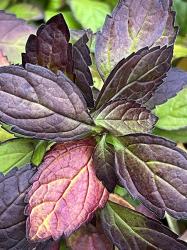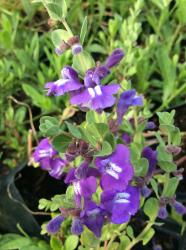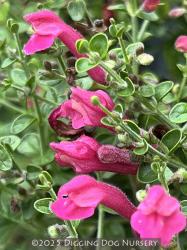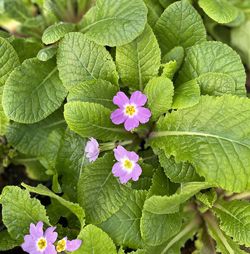Scutellaria
Skullcap
Late in the season, after the charming hooded blooms have faded, pairs of scallop-shaped, warmly colored seed capsules, resembling small inverted skullcaps, add intriguing detail to these Mint family members. Our easy-to-grow selections appreciate a sunny, quick-draining site, and happily mingle with medium-sized Euphorbias, Diascias and Nepetas.
Scutellaria alpina ‘Moonbeam’ (P-1226)
Each $11.00
The species originates in the mountains of southern Europe and Russia, and this ‘Moonbeam’s lush and low bushy mat of scalloped, ovate green-gray leaves is an excellent foil for its crowded clusters of light yellow blooms. Trailing stems turn upward and, at their tips, Snapdragon-like flowers form a four-sided raceme.
Requiring well drained soil and shade during hot afternoons, this little treasure goes well in a container, or in the rockery with Edraianthus graminifolius and Origanum libanoticum.
Blooms May–September.
Size: 10" high x 12" wide.
Hardy to zone 5.

Originating as a seedling from a naturally occurring hybrid between two eastern U.S. natives Scutellaria ovata and Scutellaria serrata, this first-rate 2022 cultivar was selected by West Virginia-based horticulturalist Peter Heus and introduced by Plants Nouveau. Dapper serrated mint-green leaves with plum-colored margins distinguish the snug semievergreen clump, which premiers large Salvia-like violet-blue and white bicolored flowers on upright, branching dark maroon stems. Happiest in filtered light plus well-drained soil, ‘Appalachian Blues’s amenable deer-resistant habit attracts numerous bee species, tolerates occasional drought and promises long-lasting charm for sunny, moist meadow plantings, mixed borders and woodland peripheries.
Blooms late May–July
Size: 15" – 2' 0" high x 15" – 2' 0" wide.
Hardy to zone 4.
Scutellaria incana ‘White Sky’ (P-2157)
OUT OF PRODUCTION AT THIS TIME
Email me when this plant is available
While the native species roams the meadows, open woodlands and shady stream banks and roadsides of the eastern U.S., this new easily grown white-flowering cultivar will illuminate the bright shadows of your garden. Openly arranged, tubular pearl-hued flowers with a hood-like upper lip, light green bracts and plenty of pollinator allure distinguish glimmering 6 in. terminal racemes. Softened by ultrafine downy gray hairs, the dense bushy habit forms an attractive small colony of erect square green stems clothed in ovate, round-toothed smoky-green leaves with pointed tips and a bitter taste that keeps bunnies and deer at bay.
Blooms mid June–August
Size: 2' 0" – 3' 0" high x 12" – 2' 0" wide.
Hardy to zone 4.

Legendary for its tenacious ability to conquer hot sunny niches, this engaging well-groomed Kansas denizen was introduced by the Nebraska Statewide Arboretum. Small, oval-shaped pubescent gray-green leaves and branching, upright square stems cushion a showy, long-lasting display of tubular deep blue-violet flowers, each highlighted with 2 small white streaks. Relishing minimal fertility plus sharp drainage, ‘Smoky Hills’ is second-to-none when massed as a low mounding ground cover that readily enhances borders, meadows, rock gardens and native plantings while warding off the bunnies.
Blooms May–July
Size: 6" – 12" high x 10" – 14" wide.
Hardy to zone 4.

For its tidy swath of dark pink infill, the masses of Snapdragon-like blooms adorning the diminutive, glossy green foliage of ‘Texas Rose’ get our vote. With a dainty, yet durable, low profile, it makes an endearing addition to the rockery, or along a pathway nestled amidst Dianthus ‘Mendlesham Maid’ and Geranium ‘Johnson’s Blue’.
Blooms mid-June–mid-October.
Size: 4" – 6" high x 15" wide.
Hardy to zone 7.











